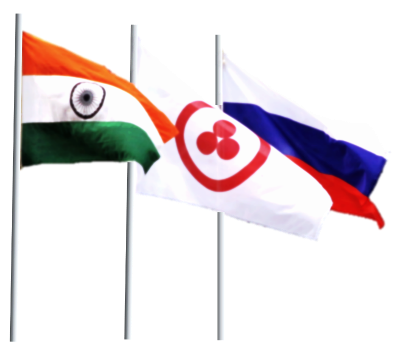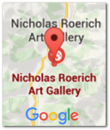09.05.2025
Exhibition of Nicholas Roerich’s painting reproductions dedicated to 80th anniversary of the Victory in Great Patriotic War
On 9 May, an exhibition of reproductions of Nicholas Roerich's paintings was inaugurated at the International Roerich Memorial Trust in Naggar. This exhibition was dedicated to the 80th anniversary of victory in the Great Patriotic and Second World Wars.
At the same time, the Russian theme becomes increasingly prominent in Roerich’s art. He wrote essays dedicated to Russian culture, literature and theatre. In these writings, he praises the courage of the Russian people and their ability to respect and understand all things foreign. He also praises their absence of chauvinism and nationalism, which plagued Europe in the 1930s.
Russian heroes from the distant past start to appear more frequently in Roerich’s paintings. The titles of the paintings speak for themselves: 'For the Feat', 'St. Sergius', 'Bogatyrs Awoke', 'Light Conquers the Dark' and others.
In 1940, he wrote in his esseys he expresses confidence in the coming victory, as if he could foresee the inevitable turn of events: 'Nothing is terrible for the Great Russian People. Everything will be defeated: ice, heat, glaze and thunderstorms. They will build to their heart's content.”
From the very beginning of the war, the Roerichs seized every opportunity to support their homeland. They held charity exhibitions and sold their paintings, donating all the proceeds to the Red Army and the Soviet Red Cross. They also spoke on Indian radio in support of the Red Army.
Following the outbreak of war, Roerich created a series of particularly poetic paintings with a strong patriotic theme, collectively known as the Heroic Series. Some of these paintings, including 'Mstislav's Fight with Rededya', 'Partisans', 'Svyatogor' and 'Alexander Nevsky', were presented at the exhibition. Through these works, the artist both foresaw and praised the heroic rise of the Russian people in their fight against absolute evil, and their subsequent victory over fascism. It seems that artists dedicated all the paintings from the pre-war and wartime periods with the same message: 'To the Great Russian People'. This is the title of one of his numerous essays, which he wrote to support the Soviet people in their holy battle. Making heroes of Russian folk epics main subjects of his paintings, the artist reflects the qualities of the people that make victory inevitable: courage, unity in the face of danger, heroism and a heightened sense of justice. "In the midst of troubles and grief, the people compose a new glory for their beloved Motherland. Heroes of war, heroes of labour, heroic mothers, heroes of culture — a great, invincible host of heroes!' writes the artist.
Thus, through his daily labour, the artist brought victory closer, drawing on all his strength and creativity from his home in India. As early as 1942, three years before the war ended, he created the prophetic painting 'Victory'. He knew that the victory was imminent and that the Russian people would surely win. After long-awaited victory in spring of 1945, he created a painting dedicated to it: 'Sacred Spring'. 'It was all done for the glory of Russia.' Russian victories are rumbling. The Russian people are forging a great future.’ ‘Victory! Victory! And how many more victories lie ahead,’ he wrote.
In the year of the 80th anniversary of victory, all of Roerich's works – his writings and his heroic paintings dedicated to his beloved Motherland – remain as relevant as ever.
The grand opening of the artist's exhibition concluded with a viewing of the Victory Day Parade on the Red Square, held in honour of the anniversary. Both Russian and Indian guests attended the event.
The exhibition showcased the artist's masterpieces, with a particular focus on his dedication to his Motherland, the tragic events of the 1930s and 1940s, and the heroic fight and victory of the Soviet peoples over the fascist invaders.
Nicholas Roerich was able to foresee the tragic events that were to come long before the Second World War began. In the early 1930s, he created the paintings entitled 'Blaze' and 'Armageddon', which foresaw the fire and ashes resulting from the impending new war. Simultaneously, he initiates a dynamic cultural programme in support of the Roerich Pact, a legal accord designed to safeguard cultural heritage during periods of conflict and peace. He was aware that time was of the essence.
As early as 1936, he had written an essay entitled 'Defence', in which he stated: "The defence of Motherland is synonymous with the defence of culture. ,<...> Our Great Motherland! We will defend all your spiritual treasures, all your unsaid beauty, all the endlessness of your spaces and summits."















